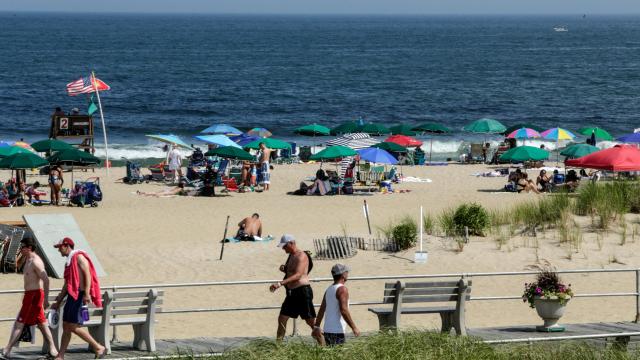I don’t go to the beach for the sand or the sun. I go for the waves. There’s nothing like splashing in the water after lugging your cooler, chair, and beach umbrella to your designated spot. Unfortunately, I may need to think twice about going for a swim at the beach. And so should you, if you live in the United States.
A new report out Tuesday has found that more than half of the beaches in coastal states, the Great Lakes states and Puerto Rico saw at least one day in 2018 where their water wasn’t safe for swimming. Why? Bacteria levels were higher than what the Environmental Protection Agency deems acceptable.
Yeah, gross.
The report — put out by Environment America and Frontier Group, both advocacy groups dedicated to improving the environment — looked at national data from 4523 beach sites in 29 U.S. states. The report authors measured the beach’s quality using the EPA standard, which measures the concentration of bacteria in a sample of beach water. Literal shit from runoff and sewage is the main source of this nasty-arse pollution.
This pollution can expose swimmers to illness or infection, especially people with compromised immune systems or the very young or elderly. Individuals may walk away from their beach day with an ear or eye infection or perhaps even gastroenteritis, which may involve a fever, puking, or painfully spending the day on the toilet. Nearly 7000 people died in 2017 due to pathogens transmitted by water, according to the U.S. Centres for Disease Control and Prevention.
At 605 of the beaches, the researchers found the water was unsafe 25 per cent of the days sampled, according to data pulled from the National Water Quality Monitoring Council. Local, state and federal agencies submit local sampling information to this database. Gulf Coast states, like Texas, Louisiana, and Florida, saw 85 per cent of their sites unsafe for at least one day last year. East Coast beaches are seemingly the safest. Only 48 per cent were unsafe at least one day last year.
Typically, if a beach is experiencing unsafe levels of bacteria, the local or state agency responsible for it will issue a health advisory so that people don’t swim. Still, as the report makes clear, issues of water quality have existed for decades. Yet here we are — still dealing with the same old thang. Shouldn’t we have stopped polluting our waterways by now?
The report suggests improving sewage infrastructure and building systems to capture runoff before it reaches the ocean. Regulators could also enforce the legal protections that already exist for our waterways. That way, less industry, from livestock to wastewater treatment, dumps their shit into our water.
